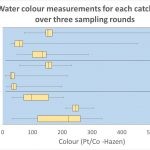Tapestry of Light Silver netting of the dawn, Embroidered through…
Ireland’s Blanket Bogs – more dynamic than meets the eye
Raymond Flynn and Michael Anderson from Queen’s University Belfast’s explain how Ireland’s blanket bogs are affected by the hydrology of their catchments.
Understanding how water flows through these landscapes will be key to protecting them and restoring them. Instruments measuring rainfall, runoff, evapotranspiration and groundwater levels have been installed at three sites in Antrim, Cavan and Sligo and these data are being complemented by detailed vegetation mapping and water quality monitoring.
Those who pay regular visits to blanket bogs will know how important hydrology can be for getting around. On all-too-frequent rainy days streams can flow with an energy that can pose a risk to the life to those brave (or mad) enough to try and cross them. Yet shortly after rainfall stops, flows can decline quickly and can be low enough to allow people to safely skip across a few hours later, reflecting the speed in which these processes can change. Of course rainfall and runoff are only two of the hydrological processes that affect blanket bogs, albeit those that have received the lion’s share of attention from the hydrological community. Other processes, such as groundwater flow through peat, remain somewhat neglected, with many researchers assuming that blanket peat is low permeability mass of saturated organic material that prevents rainfall from infiltrating. Put another way, all the action would appear to occur above ground. However, appearances can be deceptive. Despite their flashy nature, many streams draining blanket bog catchments continue to flow, even during prolonged dry spells, prompting the question “where does this water come from?” Looking at this in more detail suggests that the idea that all stream discharge comes from overland flow, unable to infiltrate through the peat, may be an over simplification and that processes may be more complex.
Understanding how and why water behaves as it does in blanket bogs has become increasingly relevant in recent years, with the need to better characterise aquatic ecosystem supporting conditions in many of the high status water bodies that blanket peat-covered catchments host. This has become all the more pressing due to widespread deterioration of many with recent upland developments. As most readers of the Catchments Newsletter will be aware, Water Framework Directive legislation requires this deterioration to be restored, even though we may not know how to do so. Better understanding hydrological processes provides an important stepping stone for addressing this issue.
As part of the EPA-funded “Toward the Quantification of Blanket Bog Ecosystem Services (QUBBES)” investigation, researchers at Queen’s University Belfast have initiated a series of integrated studies on blanket peat covered catchments to better understand their hydrology. Instrumentation installed at relatively intact sites in counties Antrim, Cavan and Sligo makes regular highresolution measurements of rainfall, runoff, evapotranspiration and groundwater levels. These measurements have been complemented by vegetation mapping and water quality monitoring with a view to better addressing the controversy around whether blanket bogs act as sponges or not, and to what degree their natural hydrological processes have been altered by human activity. This in turn provides a basis for examining changes in water quality over time frames from individual storm events to longer term trends.
In investigating these issues it has become apparent that contributions to stream flow are more complex than originally assumed. In response, researchers’ attention has expanded to consider the role of groundwater flow through peat, and the contribution it makes to runoff. Although a number of publications have examined the issue of peat hydraulic conductivity, few have expanded this to consider groundwater flow rates. And besides, consensus on measurement of peat hydraulic conductivity measurement remains inconclusive.


Tracer testing forms an alternative means of investigating blanket bog hydrogeology, without the need to measure either hydraulic conductivity or hydraulic gradient. Measuring the rates of change in concentration of easily detectable tracers, either in single wells, or between wells provides a useful tool to better understand groundwater flow and its variability. Peat is ideally suited to these types of investigations, given the ease with which monitoring wells can be installed. On the other hand perceptions about its very low hydraulic conductivity have meant that the technique has been rarely used in the past. QUBBES researchers examined this issue in more detail. During spring and summer 2018 researchers installed an array of tracer test wells in blanket peat in the Collin Burn Catchment in the QUBBES Garron Plateau Test Site, Co. Antrim. Initial single well tests revealed tracer levels declining to one tenth of their starting concentration in a matter of hours, suggesting that groundwater flow rates were considerably higher than expected (Calculated values were of the order of 0.1m/day). Similarly flow velocities were observed elsewhere across the site.

The findings from single well dilution tests prompted the researcher team to undertake multiple well tracer testing, where tracer was injected into one well and monitored at observation wells down gradient. Figure 2 provides an example of the type of breakthough (tracer concentration with time) curve obtained. Results confirmed findings of single well tests, while also indicating a large variety of groundwater flow velocities for groundwater flowing through blanket peat.
Mathematical modelling of breakthrough curves using single velocity and dispersion terms failed to satisfactorily simulate the responses observed in the field. On the other hand the introduction of a second term generated a reasonable fit. But on what physical basis? Coring the peat provided the answer. Samples collected using a 50mm ID Russian Auger revealed 30cm-50cm of relatively undecomposed moss-rich peat, underlying the uppermost 5cm-10cm of highly decomposed peat; the moss -rich overlay more amorphous (highly decomposed) material. Tests in comparable material elsewhere have shown flow rates through the fresher material are considerably higher than those at depth. The widespread occurrence of this deposit at the site suggests that flow below the bog surface can provide an important pathway for delivering groundwater to rivers and streams. This contrasts with the idea that blanket peat is an amorphous low permeability mass.
The results of this study, although brief, have provided a basis for challenging preconceptions about groundwater flow through blanket peat, while further underscoring the importance of subsurface process in delivering water to streams in peat covered catchments. From another perspective the study has emphasised the value of tracer testing in Irish hydrogeological investigations, beyond its conventional application in karst systems. Ongoing work on this topic at Garron aims to integrate these results into numerical models to better understand how blanket bogs function and the ecosystem services they can provide to society.







